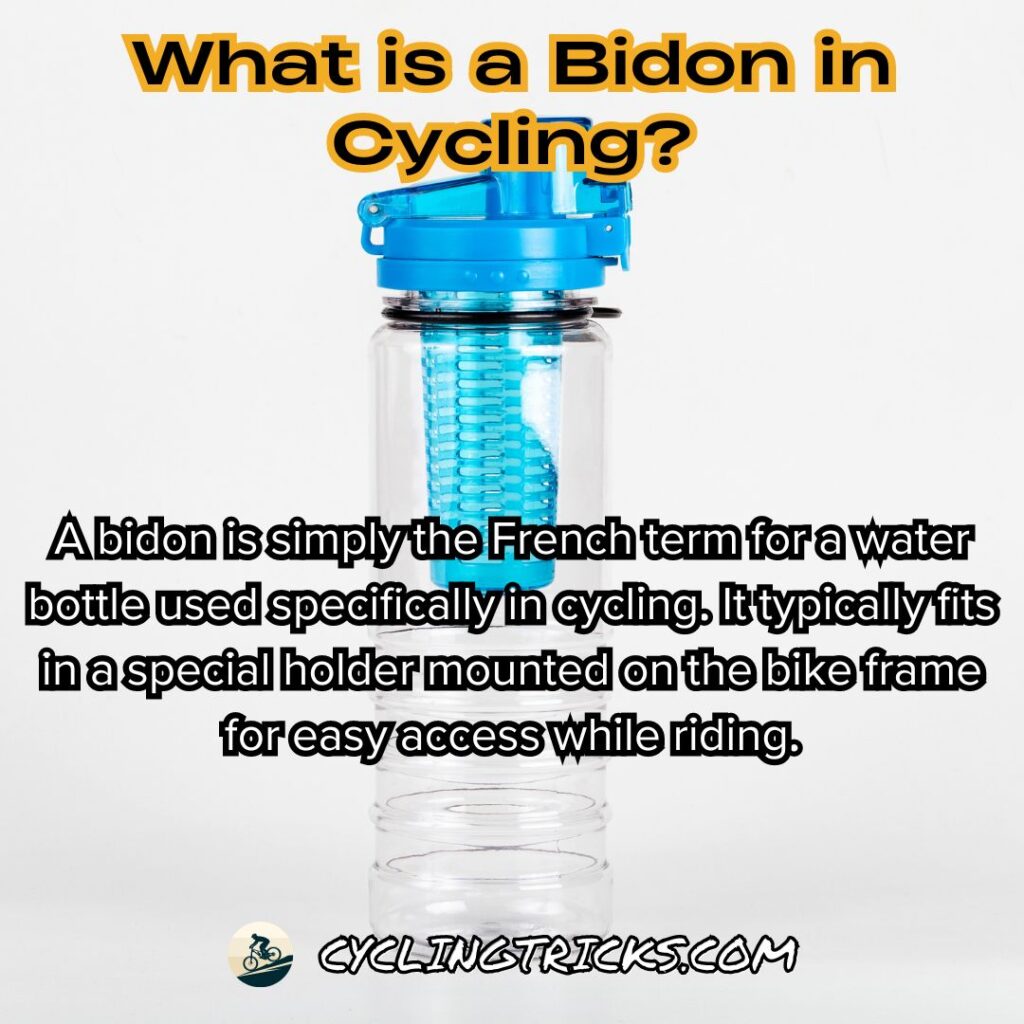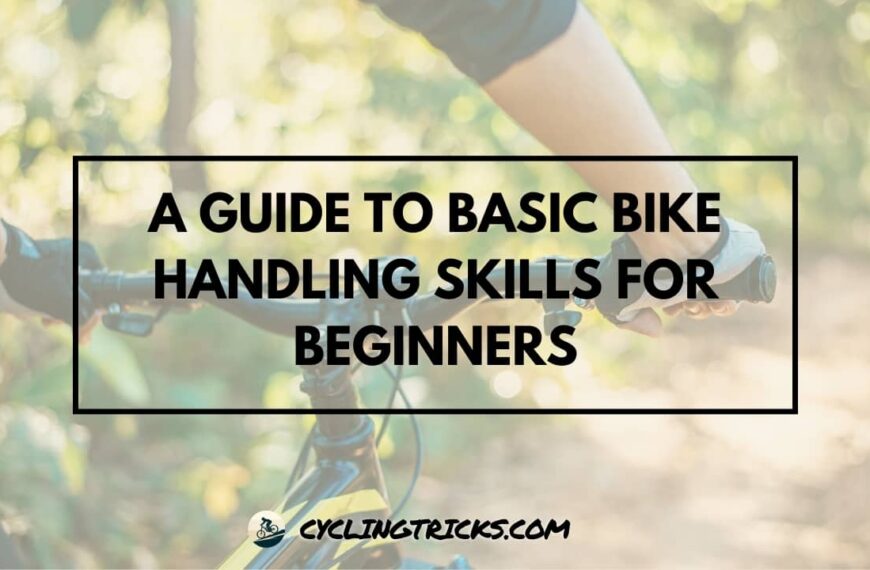Ever crushed a 100-mile ride feeling totally dehydrated? Believe it or not, pro cyclists can sweat up to 2 liters per hour!
That’s why every cyclist needs a trusty bidon (bike water bottle) by their side.
But with all the fancy shapes, sizes, and features, what exactly is a bidon, and how do you choose the right one for you?
Let’s crack open the world of bidons and keep you hydrated on every ride!
Key Takeaways
- A bidon is specially designed with cyclists’ needs in mind, featuring easy-to-use and secure elements.
- Not just any water bottle, a bidon includes aerodynamic shapes and leak-proof designs.
- Fitting snugly into a cage attached to the bike, bidons are made to endure rough rides without falling out.
- Hydration on the go is crucial, and the bidon allows for fluid intake without slowing down or losing focus.
- While selecting a bidon, features like the material, size, and type of cap are important for a cyclist’s convenience and efficiency.
- Understanding the function and importance of bidons can enhance performance and overall cycling experience.
What is a Bidon in Cycling? (To-The-Point Answer)
A bidon is simply the French term for a water bottle used specifically in cycling. It typically fits in a special holder mounted on the bike frame for easy access while riding.

Unveiling the Bidon: A Staple in Every Cyclist’s Gear
Embark on a journey to truly understand the quintessential component of cycling gear. Discovering the multi-faceted nature of the bidon is crucial, as it is not just a receptacle for your drinks but an embodiment of practicality and efficiency for your rides.
Understanding the Bidon Definition
At its core, the bidon definition relates to a specialized container designed for cyclists to carry liquids, primarily water. The term itself has French roots, but its application is known worldwide among cycling enthusiasts. Prioritizing functionality, bidons are tailored to meet hydration needs with ease of access during the most rigorous of rides.
Comparing Bidon Types and Materials
The choice of bidon types and bidon materials is extensive, catering to diverse preferences and performance requirements. Whether you favor the traditional, lightweight BPA-free plastic bidons or the more sturdy, insulated stainless steel options, there’s a bidon crafted just for your cycling routine.
| Material Type | Pros | Cons | Best Use |
|---|---|---|---|
| Plastic (BPA-free) | Lightweight, flexible | May retain taste and odor | Everyday riding |
| Stainless Steel | Durable, insulates temperature | Heavier than plastic | Long rides, varying temperatures |
| Aluminum | Lightweight, durable | Can dent, may require lining | Competitive cycling |
Bidon Function: More Than Meets the Eye
A bidon’s function surpasses its basic role of storing fluids. Designed with a cyclist’s dynamic movement in mind, features like the squeeze body for smooth water flow and the easily opened mouthpiece using just your teeth, ensure uninterrupted hydration. It’s this intricate blend of features that makes a bidon an indispensable ally during intense cycling endeavors.
The Importance of Bidon Usage in Cycling
Understanding the bidon importance goes far beyond acknowledging it as a mere accessory. In the realm of cycling, where endurance and hydration are intrinsically connected, bidon usage in cycling stands as a fundamental aspect of a cyclist’s performance.
The purpose of a bidon is multifaceted, ranging from providing quick hydration to serving as a vessel for bidon sports drinks that replenish a cyclist’s energy levels.
- A bidon allows you to maintain consistent hydration, which is vital for long-distance rides where water access may be scarce.
- When filled with sports drinks, bidons offer a convenient source of electrolytes and carbohydrates, which are essential for sustaining energy and preventing fatigue.
- The design and functionality of bidons make them easily accessible, promoting efficient water intake without distracting you from your cycling rhythm.
Let’s delve into the bidon purpose by evaluating its role in a cyclist’s nutrition and performance:
| Hydration Needs | Bidon with Water | Bidon with Sports Drink |
|---|---|---|
| Quick thirst quenching | Perfect for immediate hydration | Not as satisfying as water for thirst |
| Electrolyte replenishment | Lacks electrolytes | Contains essential salts and minerals |
| Energy supply | Does not provide calories | Offers carbohydrates for energy |
| Cooling effect | Can be pre-chilled for refreshment | Also can be chilled; contains additives to aid in absorption |
| Long rides | Essential to prevent dehydration | Also can be chilled; contains additives to aid in the absorption |
In essence, bidons are not only containers but also crucial tools for cyclists. Whether you’re tackling a steep incline, racing against the clock, or simply enjoying a scenic route, a bidon is your steadfast companion in sustaining optimal bidon usage in cycling.
Remember, when preparing for your next cycling venture, to consider not just the quantity but also the quality of the fluids in your bidon, as they are key to maintaining performance and enjoying your ride to the fullest.
What is a Bidon in Cycling? The Detailed Explanation
Delving into the world of road cycling, one item stands out as particularly vital to the cyclist’s journey: the bidon. But what is a bidon in cycling and why is it considered indispensable?
Essentially, a bidon is a cycling water bottle designed specifically for the needs of cyclists. Its ergonomic form is perfect for grasping quickly and effortlessly, and its construction is lightweight to not add unnecessary weight to the bike. The significance of a bidon in cycling cannot be overstated—it’s the cyclist’s portable hydration station.
When discussing bidon usage, it should be noted that efficiency and accessibility are key. A well-designed bidon cycling bottle allows riders to hydrate without having to stop or even slow down, a crucial factor in both competitive racing and endurance training. This is achieved thanks to the bidon’s compatibility with the bike’s bidon cage, a secure holder attached to the bike frame, which keeps the bidon within arm’s reach at all times.
- Lightweight Design: No added bulk, maximizing performance.
- Secure Cage Fit: Ensures the bidon remains intact on rough terrains.
- Easy Access: Drink effortlessly without losing momentum.
- Hydration Options: Carry water or sports drinks to stay energized.
For those wondering what is a bidon in cycling explained simply, imagine cycling uphill on a hot day. The exertion is intense, and your body is sweating out vital salts and minerals. You reach down without looking, secure in the knowledge that your bidon is there. With a quick squeeze, the water or sports drink flows, the spout is designed to allow easy drinking even when your heart is pounding and your breath is short. That’s the bidon’s role—keeping you hydrated, keeping you pushing forward, keeping you on the bike.
In road cycling, where every second and every ounce counts, the bidon is a testament to the meticulous attention to detail that defines the sport. As you grip the handlebars, your bidon stands ready, a symbol of preparation and resilience.
So whether you’re tackling the local bike path or competing in the Tour de France, remember: your bidon is more than just a container, it’s a crucial companion on every journey.
How To Choose The Right Bidon: Features and Considerations
When you’re out on a ride, the last thing you want is to struggle with hydration. That’s where bidon cycling gear steps in, ensuring you stay adequately hydrated without slowing down. But with the wide array of bidon types and features available, how do you choose the right one?
Here’s what you should consider:
- Capacity: How much fluid do you need? Bidons come in various sizes, usually ranging from 500ml to 1000ml. Consider the duration and intensity of your rides to decide on the right size.
- Material: The bidon materials determine not only the taste of your drink but also its weight and durability. Common materials include BPA-free plastic and stainless steel, with the latter being better for insulation.
- Nozzle Design: A good nozzle should allow you to open it with your teeth and provide a high flow rate for quick hydration.
- Insulation: If you frequently cycle in warm weather, an insulated bidon helps keep your drinks cold for longer periods.
- Visibility: Some bidons have a clear strip or are entirely transparent to let you know at a glance how much liquid remains.
Remember, the best bidon for you should align with your bidon preferences for convenience and performance on the road. Whether you’re a casual weekend rider or a hardcore racer, selecting the right bidon features can make a significant difference in your cycling experience.
Bidon Holders and Cages: Securing Your Hydration
As you power through each mile, the bidon attached to your bike serves a crucial role in keeping you hydrated. Understanding the different types of bidon holders, commonly referred to as cages, can help ensure you have your water close at hand without any disruptions to your ride. Let’s explore the options and how they cater to the specific needs of cyclists.
Types of Bidon Cages for Different Bikes
Bidon cages are diverse in their construction to meet the varying demands of cyclists. Whether you’re a mountain biker, road racer, or urban commuter, there’s a bidon holder designed for your bike. Models crafted from carbon fiber offer a lightweight solution that’s popular among performance-focused road cyclists.
On the other hand, mountain bikers might prefer the ruggedness of metal or plastic cages that can withstand the rigors of off-road terrain. The design of the bidon cage is also pivotal in allowing quick and easy access for you to grab your bidon mid-ride.
How to Choose and Install a Bidon Cage
To ensure the optimal balance of weight, durability, and ease of bidon access, consider the following when choosing your bidon cage:
- Material: Reflect on the type of riding you do and choose a material that aligns with your needs—carbon fiber for lightness, metal for strength, or plastic for affordability and flexibility.
- Bidon Cage Design: Look for designs that allow for secure storage yet easy retrieval of the bidon, especially while in motion.
- Compatibility: Ensure the bidon holder fits your bike frame and is suitable for the size of bidon you plan to use.
- Installation Fixture: Verify if your bike has the necessary mounting points and choose a cage that matches these specifications.
If you’ve never installed a bidon cage, worry not. The process is straightforward and can be completed with basic tools—typically requiring just a screwdriver or an Allen key.
Make certain that the bidon cage is mounted securely to prevent any movement or ejection during bumpy rides. A well-fitted bidon cage becomes an extension of your bike, allowing for seamless bidon function, avoiding any unnecessary distraction that could affect your ride.
| Material | Typical Use | Pros | Cons |
|---|---|---|---|
| Carbon Fiber | Road Cycling | Ultra-lightweight, aesthetic appeal | Higher cost, less durable in crashes |
| Metal (Aluminum or Steel) | Mountain Biking, Touring | Durable, often more affordable than carbon | Heavier than carbon fiber |
| Plastic | Casual Riding, Commuting | Good flexibility, variety of shapes and colors | May not hold bidon as tightly as metal options |
For a successful cycling excursion, it is essential to have the right essentials in place. A bidon holder is more than just a convenience; it’s a critical piece of equipment that ensures your bidon is always an arm’s length away, ready to keep you refreshed and focused on the road ahead.
Conclusion
Alright, cyclists! We’ve shown you that the bidon is more than just a water bottle; it’s the key to staying hydrated and getting through those long rides. Remember that the right bidon makes you feel good, helps you concentrate, and lets you do your best.
Are you ready to learn more about cycling-related stuff? Visit our other cycling articles for essential gear recommendations and other cool tips.
Now go ride and have fun!









